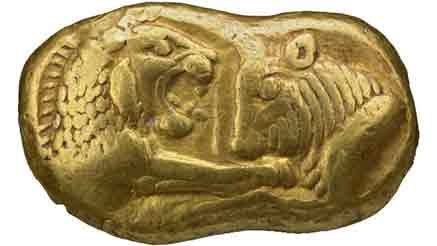Gold Stater of Croesus
The gold Stater of Croesus was the world’s first gold coin. It features a bull and a lion facing one another. Art was now used to adorn the surface of coins to identify the coin with the coin producer.

Lydia’s King Croesus
King Croesus reigned over Lydia from 561 to 547 B.C. Located in modern-day Turkey, Lydia was known for its skilled warriors and bustling trading centers. While Croesus was in power, the Mermnad Dynasty transformed into an empire by waging military campaigns in Ephesus, as well as Aeolian and Ionian cities.
In addition to his military might, Croesus was known for his lavish wealth, which he displayed by building a massive palace in Lydia’s capital of Sardis. The expression, “As rich as Croesus,” lives on today. While Croesus was arguably Lydia’s most well-known king, he was also its last. The empire fell to the Persians in 547 B.C.
Pure Gold Staters
King Croesus’ focus on developing coinage allowed his kingdom to expand its influence. Croesus was the first Lydian king to issue coins comprised of pure silver and pure gold. Under his father’s reign, Lydian staters were made of electrum, a naturally occurring substance that includes a combination of the two metals. According to myth, Lydia’s Pactolus River was rich in metals because King Midas of Phrygia washed in the river seeking to remove his curse of the “golden touch.”
While other ancient civilizations were experimenting with coins, the Lydians were the first to create a bi-metallic currency. As Herodotus wrote in the fifth century B.C., the Lydians were “the first people we know of to strike gold and silver coins and use them.”
Relying on an innovative refining process, the Lydians were also the first to issue coins of standard weight and purity. Gold staters weighed 126 grains, while the silver staters weighed 168 grains. Each coin was stamped with the lion and bull image, with the lion believed to symbolize strength and the bull to represent fertility.
While the Lydians were assimilated into the Persian Empire, their coinage survived. In fact, historians believe that the Persians continued to use the Sardis mint long after they assumed control. The notion of gold coins soon spread to other kingdoms in Asia Minor and then throughout Greece. The standardization of coinage allowed to the ancient world to gradually transition from the barter system to a system of currency, which we still use today.
